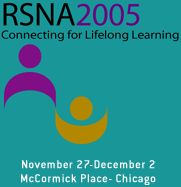
Abstract Archives of the RSNA, 2005
Kambiz Nael MD, Presenter: Nothing to Disclose
Roya Shakery Saleh, Abstract Co-Author: Nothing to Disclose
Margaret Hsin-Shung Lee MD, Abstract Co-Author: Nothing to Disclose
Stefan Georg Ruehm MD, PhD, Abstract Co-Author: Nothing to Disclose
Gerhard Laub MD, Abstract Co-Author: Nothing to Disclose
Paul Finn MD, Abstract Co-Author: Nothing to Disclose
To evaluate the renal and visceral arterial branches in patients with suspected arterial stenosis using 3D CEMRA at 3.0 Tesla (3T).
25 consecutive patients (10 M, 31-78 years old) with suspected visceral or renal artery stenosis (RAS) were studied on a whole body 3T system using an 8 channel body array coil. During infusion of 25 ml gadodiamide at 1.5 ml/s, a fast 3D GRE sequence (TR/TE: 2.84/1.03; FA: 20°; BW: 700 Hz/Px; FOV: 360-300 mm; matrix: 512x400; voxel size: 0.8 x 0.7 x 0.9 mm & GRAPPAx3) was acquired in the coronal plane during a 20 second breath-hold.
The following 13 arterial segments were scored by two radiologists: suprarenal & infrarenal aorta; bilateral renals, celiac trunk, SMA, IMA, common iliacs, external iliacs, & internal iliacs. They used a 1-5 scale (poor 1- sufficient for diagnosis 3-excellent 5). Vascular occlusive disease was scored based on a 1-3 scale (<50% 1, ≥50-99% 2, occlusion 3). Interobserver agreement was evaluated by weighted-kappa test. 6 patients had conventional angiographic correlation.
All 13 segments in all subjects (100%) were visualized with definition in the range (4.92±0.22, κ=0.9). Vascular pathology was found in 54 arterial segments, including 15 with 50-99%, and 2 occlusions in a total number of 12 patients. In 6 patients with conventional angiography, the MRA findings were confirmed, and showed the sensitivity and specificity of 100 & 100% for evaluation of RAS.
Initial results suggest that CEMRA at 3T is extremely promising for evaluation of renal and visceral arteries. Higher SNR available at 3T and more effective use of parallel acquisition can be used to improve the spatial resolution, generating sub-millimeter voxels (0.50mm³) in a comfortable breath-hold, rivaling the spatial resolution of multi-slice CT.
P.F.: Consultant for Siemens Medical Solutions & GE-Amersham Health CareG.L.: Employee of Siemens Medical Solutions
Nael, K,
Shakery Saleh, R,
Lee, M,
Ruehm, S,
Laub, G,
Finn, P,
High Spatial Resolution 3D Contrast-enhanced MRA (CEMRA) of the Abdomen at 3.0 Tesla. Radiological Society of North America 2005 Scientific Assembly and Annual Meeting, November 27 - December 2, 2005 ,Chicago IL.
http://archive.rsna.org/2005/4411605.html

